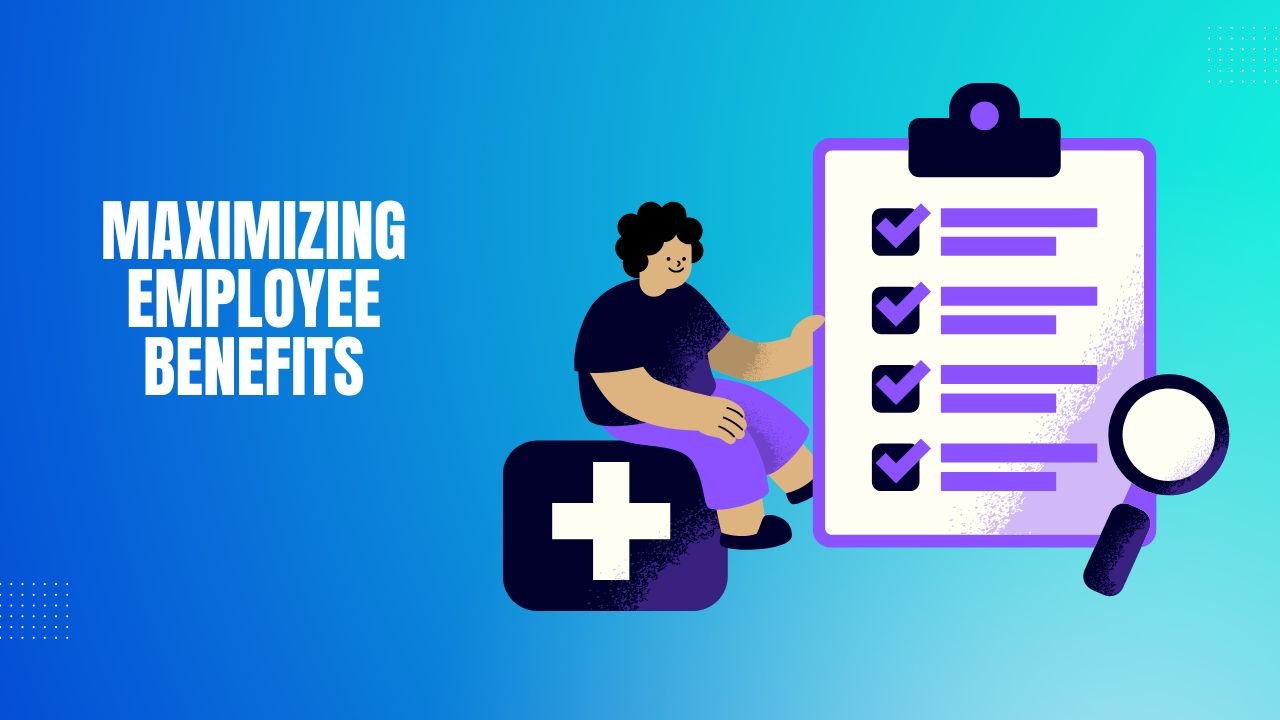Did you know that one of the most valuable assets your employer can offer you is employee benefits and perks? Yup, you heard it right!
A recent study conducted by the Society for Human Resource Management revealed that employee benefits make up around 30% of an employee’s total compensation.
That’s a significant chunk of change that could go a long way in improving your financial well-being.
But here’s the thing – simply having access to employee benefits and perks is not enough.
To truly reap the financial rewards of these benefits, you need to understand them, negotiate them, and maximize them.
In this article, we’ll explore the different types of employee benefits and perks available, and give you practical strategies to get the most out of them.
So, whether you’re just starting your career or have been in the workforce for a while, this article is for you.
Let’s dive into the world of employee benefits and perks and start maximizing our financial gain!
1. Understanding Employee Benefits and Perks
Employee benefits and perks are essentially the additional perks or compensations that an employer offers to an employee as a part of their employment package, besides the salary.
These benefits can take various forms and can be used to attract and retain employees in a competitive job market.
1.1 Different Types of employee benefits and Perks
Let’s take a closer look at some of the different types of employee benefits and perks:
1.1.1 Health and Wellness Benefits
This includes benefits such as medical insurance, dental insurance, vision insurance, and other health-related benefits.
Employers offer these benefits to help their employees maintain their physical and mental well-being.
These benefits can save employees thousands of dollars in medical bills and can help them get the care they need without worrying about the cost.
1.1.2 Retirement Benefits
Retirement benefits refer to the money that an employer contributes towards an employee’s retirement.
This can include 401(k) plans, pension plans, and other investment options.
These benefits are important because they help employees save for their future and ensure that they have a comfortable retirement.

1.1.3 Flexible Work Arrangements
Flexible work arrangements refer to the ability of an employee to work from home or choose their hours.
This can be a great benefit for employees who have families or other responsibilities that require flexibility in their work schedules.
1.1.4 Paid Time Off
Paid time off includes vacation days, sick days, and personal days. These benefits allow employees to take time off work without losing pay.
This is important because it allows employees to take care of themselves and their families, and can reduce stress and burnout.
1.1.5 Miscellaneous Perks
This can include benefits such as free meals, gym memberships, discounts on products or services, and other perks that may not fall under any of the other categories.
These benefits can be a great way to attract and retain employees.
1.2 Importance of understanding employee benefits and perks
Understanding the employee benefits and perks that are available to you is crucial for several reasons.
Firstly, it can help you determine whether the compensation package being offered to you is fair and competitive.
Secondly, it can help you make informed decisions about which employer to work for based on the benefits they offer.
Finally, it can help you make the most of the benefits that you do receive, allowing you to save money and improve your overall financial well-being.
In fact, according to a survey by Aflac, 87% of employees think that understanding their benefits is important for their financial well-being.
Additionally, employees who understand their benefits are more likely to use them, saving themselves money in the long run.
2. Negotiating Employee Benefits and Perks
Did you know that many employees don’t negotiate their benefits packages?
According to a survey by Glassdoor, only 28% of employees negotiate their initial job offer.
This means that many employees are leaving money on the table by not negotiating their benefits and perks.
In this section, we’ll explore the importance of negotiating employee benefits and perks, and give you some tips on how to negotiate effectively.
2.1 Importance of negotiating employee benefits and perks
Negotiating employee benefits and perks can have a significant impact on your financial well-being.
By negotiating effectively, you can increase your salary, improve your benefits package, and ensure that you’re getting the best possible compensation for your skills and experience.
Additionally, negotiating can help you build a positive relationship with your employer, showing that you’re willing to advocate for yourself and your needs.

2.2 Tips for negotiating employee benefits and Perks
2.2.1 Do your research
Before you begin negotiating, it’s important to do your research.
Research the typical benefits and perks offered in your industry, as well as the benefits and perks offered by other companies in your area.
This will give you an idea of what’s reasonable to ask for and what’s not.
2.2.2 Prioritize your needs
When negotiating, it’s important to prioritize your needs.
Make a list of the benefits and perks that are most important to you, and be prepared to negotiate for those items.
This will help you stay focused during the negotiation process and ensure that you’re getting what you need.
2.2.3 Be flexible
While it’s important to prioritize your needs, it’s also important to be flexible. Y
our employer may not be able to meet all of your requests, so be prepared to compromise.
For example, if your employer can’t offer a higher salary, they may be able to offer additional paid time off instead.
2.2.4 Practice your negotiation skills
Negotiating can be uncomfortable for some people, but it’s a skill that can be learned.
Practice your negotiation skills with a friend or family member, or consider taking a negotiation course.
This will help you feel more confident during the negotiation process.
2.3 Mistakes to avoid when negotiating employee benefits and perks
- Not negotiating at all: As mentioned earlier, many employees don’t negotiate their benefits and perks at all. This can be a costly mistake, as you may be leaving money and benefits on the table.
- Focusing only on salary: While salary is important, it’s not the only benefit that you should negotiate for. Consider other benefits and perks, such as health insurance, retirement benefits, and flexible work arrangements.
- Being too aggressive: Negotiating is important, but it’s also important to be respectful and professional. Avoid being too aggressive or demanding, as this can damage your relationship with your employer.
3. Maximizing Retirement Benefits
As a millennial, retirement may seem like a distant goal.
However, it’s never too early to start thinking about your retirement benefits.
In this section, we’ll provide an overview of retirement benefits, explain why it’s important to maximize these benefits and give you some strategies for doing so.
3.1 Overview of retirement benefits
Retirement benefits are a form of compensation that employers offer to help employees save for retirement.
These benefits typically include retirement plans, such as 401(k)s, IRAs, and pensions, as well as Social Security benefits.
By participating in these plans, employees can save for retirement and ensure a stable income during their golden years.

3.2 Importance of maximizing retirement benefits
Maximizing your retirement benefits is crucial for ensuring a comfortable retirement.
According to a study by the National Institute on Retirement Security, millennials are facing a retirement savings shortfall of $4.3 trillion.
By maximizing your retirement benefits, you can avoid being part of this statistic and ensure that you have enough money saved for a comfortable retirement.
3.3 Strategies for maximizing retirement benefits
- Start early: The earlier you start saving for retirement, the better. By starting early, you’ll have more time for your investments to grow and compound. Consider enrolling in your employer’s retirement plan as soon as you’re eligible, and contribute as much as you can afford.
- Take advantage of employer matching: Many employers offer matching contributions to their retirement plans. This means that for every dollar you contribute, your employer will also contribute a certain amount. Make sure you’re contributing enough to take full advantage of this benefit.
- Diversify your investments: Diversifying your investments can help reduce your risk and maximize your returns. Consider investing in a mix of stocks, bonds, and mutual funds, and adjust your portfolio as needed to ensure that you’re meeting your retirement goals.
- Consider a Roth IRA: A Roth IRA is a retirement account that allows you to contribute after-tax dollars, which means that your withdrawals in retirement will be tax-free. This can be a great option for millennials, who are likely to be in a lower tax bracket now than they will be in retirement.
3.4 Comparison of different retirement plans
There are several different types of retirement plans, each with its benefits and drawbacks. Here’s a brief overview:
- 401(k): A 401(k) is a retirement plan offered by many employers. Employees can contribute pre-tax dollars, and many employers offer matching contributions. Contributions and earnings are tax-deferred until withdrawal.
- IRA: An IRA is an individual retirement account that you can set up on your own. Contributions may be tax-deductible, and earnings grow tax-free until withdrawal.
- Roth IRA: A Roth IRA is a type of IRA that allows you to contribute after-tax dollars. Withdrawals in retirement are tax-free.
- Pension: A pension is a retirement plan that provides a set income in retirement, based on your years of service and salary. Pensions are becoming less common, but some employers still offer them.
| Retirement Plan | Description | Employer Contribution | Employee Contribution | Tax Benefits |
|---|---|---|---|---|
| 401(k) | A defined contribution plan that allows employees to contribute pre-tax dollars to a retirement account | Varies by employer | Up to $22,500 in 2023, or $30,000 if over 50 years old | Contributions are tax-deductible, and earnings grow tax-free |
| Traditional IRA | A retirement account that allows individuals to contribute pre-tax dollars and defer taxes until withdrawal | N/A | Up to $6,500 in 2023, or $7,500 if over 50 years old | Contributions are tax-deductible, and earnings grow tax-free |
| Roth IRA | A retirement account that allows individuals to contribute after-tax dollars and withdraw funds tax-free in retirement | N/A | Up to $6,500 in 2023, or $7,500 if over 50 years old | Contributions are not tax-deductible, but earnings grow tax-free and withdrawals in retirement are tax-free |
| Pension Plan | A defined benefit plan that provides a guaranteed retirement income based on a formula that takes into account years of service and salary | Varies by employer | N/A | Contributions are not tax-deductible, but earnings grow tax-free and withdrawals in retirement are taxed as income |
Note: The above table is a simplified comparison and does not include all retirement plan options. The specific details of each plan can vary by employer and individual circumstances. It is important to consult with a financial advisor before making any decisions regarding retirement planning.
4. Health and Wellness Benefits
Health and wellness benefits are a crucial aspect of any job, as they not only impact an employee’s physical and mental well-being but can also have a significant financial impact.
Understanding and maximizing these benefits can help millennials in managing their finances better.
4.1 Overview of Health and Wellness Benefits
Health and wellness benefits refer to a variety of perks that are designed to promote the physical and mental well-being of employees.
These benefits can include health insurance, gym memberships, wellness programs, mental health support, and many more.

4.2 Importance of Health and Wellness Benefits
Access to health and wellness benefits can help employees stay healthy and productive, both of which can ultimately benefit the employer.
Additionally, these benefits can provide financial benefits such as reducing out-of-pocket medical expenses and minimizing the risk of health-related financial issues.
4.3 Strategies for Maximizing Health and Wellness Benefits:
- Understand your employer’s offerings: Read through your employer’s benefits package carefully to understand the health and wellness benefits that they offer. Take note of any perks that you can take advantage of, such as gym memberships, wellness programs, or telemedicine services.
- Make use of preventive care: Many health insurance plans offer preventive care services such as annual checkups, vaccinations, and screenings at no cost to the employee. Take advantage of these services to maintain good health and prevent any potential health problems from becoming serious issues.
- Participate in wellness programs: Some employers offer wellness programs that can help you stay healthy and active. These programs may include activities such as fitness challenges, healthy eating seminars, and stress management workshops. Taking advantage of these programs can have a positive impact on both your physical and mental well-being.
- Consider different health insurance plans: Depending on your employer, you may have several different health insurance plans to choose from. Compare the coverage and costs of each plan to determine which one is the best fit for your needs.
4.4 Comparison of Different Health and Wellness Benefits:
The table below provides a comparison of some common health and wellness benefits that employers may offer:
| Benefit | Description | Financial Impact |
|---|---|---|
| Health Insurance | Coverage for medical expenses | Reduces out-of-pocket medical expenses |
| Gym Memberships | Access to a gym or fitness facility | Can save money on gym memberships |
| Wellness Programs | Programs designed to promote physical and mental health | Can reduce medical expenses by improving health |
| Telemedicine Services | Access to healthcare services via phone or video | Can save money on healthcare costs |
| Mental Health Support | Counseling and support services for mental health | Can improve mental wellbeing and reduce medical expenses |
By understanding and maximizing the health and wellness benefits offered by your employer, you can take control of your finances and prioritize your physical and mental well-being.
5. Flexible Work Arrangements
Flexible work arrangements refer to non-traditional work arrangements that allow employees to have more control over their work schedule and location.
These arrangements include telecommuting, flexible hours, job sharing, and compressed work weeks.
5.1 Importance of Flexible Work Arrangements
Flexible work arrangements have become increasingly popular in recent years, with more and more employers recognizing the benefits they offer.
For employees, these arrangements provide more work-life balance, reduce commuting time and expenses, and allow for better management of personal responsibilities such as childcare or eldercare.
For employers, these arrangements can increase employee retention, reduce absenteeism, and improve overall productivity.

5.2 Strategies for Maximizing Flexible Work Arrangements
If you are interested in maximizing flexible work arrangements, there are a few strategies you can use:
- Identify your needs and preferences: Think about what type of flexible work arrangement would work best for you and your circumstances. Would you prefer to work from home a few days a week, or would you prefer flexible hours?
- Research your company’s policies: Check your company’s employee handbook or speak with HR to find out what flexible work arrangements are available and what the eligibility requirements are.
- Prepare a proposal: If your company does not currently offer flexible work arrangements, consider preparing a proposal outlining the benefits of such arrangements and how they could be implemented in your workplace.
- Maintain communication: When working under a flexible work arrangement, it is important to maintain regular communication with your supervisor and colleagues to ensure that everyone is on the same page.
5.3 Comparison of Different Flexible Work Arrangements
There are several different types of flexible work arrangements, each with its benefits and drawbacks. Here is a comparison of some common flexible work arrangements:
| Flexible Work Arrangement | Description | Benefits | Drawbacks |
|---|---|---|---|
| Telecommuting | Working from home or another remote location | Reduced commuting time and expenses, more flexible schedule, improved work-life balance | Reduced opportunities for collaboration and networking, potential for distractions |
| Flexible Hours | Ability to choose start and end times for workday | Improved work-life balance, ability to schedule personal appointments during work hours | Reduced opportunities for collaboration and networking, the potential for distractions |
| Job Sharing | Sharing a full-time position with another employee | Improved work-life balance, ability to work part-time while still receiving full-time benefits | Potential for communication and coordination challenges, reduced opportunities for career advancement |
| Compressed Work Week | Working full-time hours over fewer days (e.g. four 10-hour days instead of five 8-hour days) | Longer weekends, reduced commuting time and expenses, improved work-life balance | Longer workdays, potential for work-life imbalance |
Note: The specific details and availability of these flexible work arrangements can vary by employer and individual circumstances. It is important to consult with your employer to determine what options are available to you.
6. Paid Time Off
Paid time off, or PTO is a benefit that employers offer their employees to take time off from work while still receiving their regular pay.
This can include vacation days, sick days, personal days, and other types of time off.
6.1 Importance of paid time off
Paid time off is important for several reasons.
Firstly, it allows employees to take a break from work and recharge their batteries. This can improve their overall well-being and mental health, which can ultimately lead to better job performance.
Secondly, paid time off can be used for important life events, such as weddings, births, or the death of a loved one.
Finally, it can be an important part of an employer’s overall compensation package and can help attract and retain talented employees.

6.2 Strategies for maximizing paid time off
Here are some strategies for maximizing your paid time off:
- Plan: If you know you’re going to need time off for a specific event, try to request it as early as possible. This will give your employer time to plan for your absence and make sure that your work is covered.
- Use it or lose it: Many employers have policies that require employees to use their paid time off within a certain period or risk losing it. Make sure you know what your employer’s policy is, and use your time off before it expires.
- Take breaks throughout the year: Don’t wait until the end of the year to take all of your paid time off. Instead, try to take breaks throughout the year to recharge your batteries and avoid burnout.
6.3 Comparison of different paid time off policies
Different employers offer different types of paid time off policies, with varying amounts of vacation days, sick days, personal days, and other types of time off.
It’s important to review your employer’s policy to understand how much time off you’re entitled to, and what the requirements are for using it.
Here’s a table comparing some common types of paid time off policies:
| Type of PTO | Description | Advantages | Disadvantages |
|---|---|---|---|
| Traditional | Separate categories for vacation, sick, and personal time off | Provides clear guidelines for different types of time off | May be restrictive for employees who prefer more flexibility |
| PTO Bank | Single pool of time off that employees can use for any reason | Provides greater flexibility for employees | May discourage employees from taking time off when sick |
| Unlimited PTO | No set limit on the amount of time off employees can take | Provides the most flexibility for employees | Maybe difficult for employers to manage and track |
| Hybrid | A single pool of time off that employees can use for any reason | Offers a balance of flexibility and structure | Maybe restrictive for employees who prefer more flexibility |
Ultimately, the best type of paid time off policy will depend on the needs of both the employer and the employees.
It’s important to review your options and choose a policy that works best for everyone.
7. Miscellaneous Perks
Miscellaneous perks refer to the extra benefits provided by companies to their employees that do not fall under the conventional employee benefit categories.
These perks are designed to improve the employee experience, enhance productivity, and encourage loyalty.
7.1 Importance of Miscellaneous Perks
Miscellaneous perks have become an essential part of employee benefits, and companies are coming up with innovative ways to attract and retain employees.
Employees who feel valued and appreciated are more likely to be satisfied with their jobs, which leads to increased productivity and better performance.

7.2 Strategies for Maximizing Miscellaneous Perks
- Take advantage of company discounts: Many companies offer discounts to their employees for various products and services. These can range from gym memberships to travel discounts and can provide significant savings.
- Use company-sponsored events: Companies often organize social events, such as happy hours or team-building activities. These events are a great way to network with colleagues, improve morale, and take a break from work.
- Utilize free resources: Companies may offer free resources to their employees, such as wellness programs or access to online learning platforms. Take advantage of these resources to improve your skills and knowledge.
- Negotiate perks during job offers: During the negotiation phase of a job offer, consider asking for additional perks, such as a flexible work schedule or additional vacation days.
7.3 Comparison of Different Miscellaneous Perks
There are a variety of miscellaneous perks offered by companies, and the benefits and availability can vary significantly.
Some of the most common miscellaneous perks include:
- Remote work options: Many companies now offer the ability to work remotely, which provides flexibility and work-life balance.
- Free food and beverages: Some companies offer free meals or snacks to their employees, which can be a great perk for those who work long hours or have limited lunch options nearby.
- On-site amenities: Some companies provide on-site amenities, such as gyms, dry cleaning services, or even haircuts, to make life easier for employees.
- Professional development opportunities: Companies may offer opportunities for professional development, such as attending conferences or workshops, to help employees enhance their skills and knowledge.
8. Financial Planning for Employee Benefits and Perks
Importance of Financial Planning Financial planning is crucial when it comes to employee benefits and perks because they can have a significant impact on your overall financial situation.
By having a clear understanding of the benefits and perks available to you, you can create a plan to maximize your financial benefits.
8.1 Strategies for Financial Planning for Employee Benefits and Perks
- Understand the value of the benefits and perks: To effectively plan for your employee’s benefits and perks, you need to understand their value. This includes understanding the monetary value of each benefit and perk, as well as the non-monetary value.
- Prioritize your financial goals: When creating a financial plan for your employee benefits and perks, it’s important to prioritize your financial goals. Determine which goals are most important to you and allocate your resources accordingly.
- Maximize your retirement benefits: One of the best ways to maximize your employee benefits and perks is by prioritizing your retirement benefits. Consider contributing the maximum amount allowed to your retirement plan, and take advantage of any matching contributions offered by your employer.
- Consider health and wellness benefits: Health and wellness benefits can have a significant impact on your overall financial situation, particularly in terms of healthcare costs. Consider maximizing your health and wellness benefits by taking advantage of preventative care services and utilizing any wellness programs offered by your employer.

8.2 Comparison of Different Financial Planning Strategies
Different financial planning strategies can be used to maximize employee benefits and perks.
The table below compares some of the most common strategies:
| Strategy | Description | Pros | Cons |
|---|---|---|---|
| Maximize retirement benefits | Prioritize retirement benefits by contributing the maximum amount allowed and taking advantage of employer matching contributions | Provides significant long-term financial benefits | Limits short-term financial flexibility |
| Utilize health and wellness benefits | Take advantage of preventative care services and wellness programs to minimize healthcare costs | Can save significant money on healthcare costs | May require time and effort to utilize effectively |
| Prioritize paid time off | Prioritize retirement benefits by contributing the maximum amount allowed and taking advantage of employer-matching contributions | This can result in better overall financial and non-financial benefits | May limit career growth and advancement opportunities |
| Negotiate for better benefits and perks | Negotiate with your employer for better benefits and perks | Can result in better overall financial and non-financial benefits | Requires negotiation skills and may not always be successful |
| Consider outside financial resources | Utilize outside resources, such as financial advisors or savings accounts, to maximize financial benefits | Can improve the overall quality of life and mental health | May incur additional costs and require additional time and effort |
Bottom Line…
Congratulations, you have reached the end of this comprehensive guide on maximizing employee benefits and perks for financial gain!
We hope that you have gained valuable insights and strategies for maximizing your employee benefits and perks to achieve financial security and success.
It’s important to remember that employee benefits and perks can be valuable tools for achieving long-term financial goals, such as retirement savings, healthcare expenses, and paid time off.
By understanding your benefits and negotiating for the ones that best suit your needs, you can save money and improve your financial well-being.
Research shows that millennials, in particular, value employee benefits and perks that align with their values and lifestyles.
By taking advantage of flexible work arrangements, wellness programs, and other miscellaneous perks, you can create a work-life balance that supports your personal and financial goals.
Lastly, don’t forget the importance of financial planning when it comes to your employee benefits and perks.
By creating a budget, setting financial goals, and investing in retirement and healthcare plans, you can maximize the financial benefits of your employer-provided benefits.
We hope that this guide has helped you navigate the complex world of employee benefits and perks, and has inspired you to take action toward achieving financial success.
Remember, the key to financial well-being is not just about earning money, but also about making smart decisions with the money you have. Best of luck on your financial journey!
